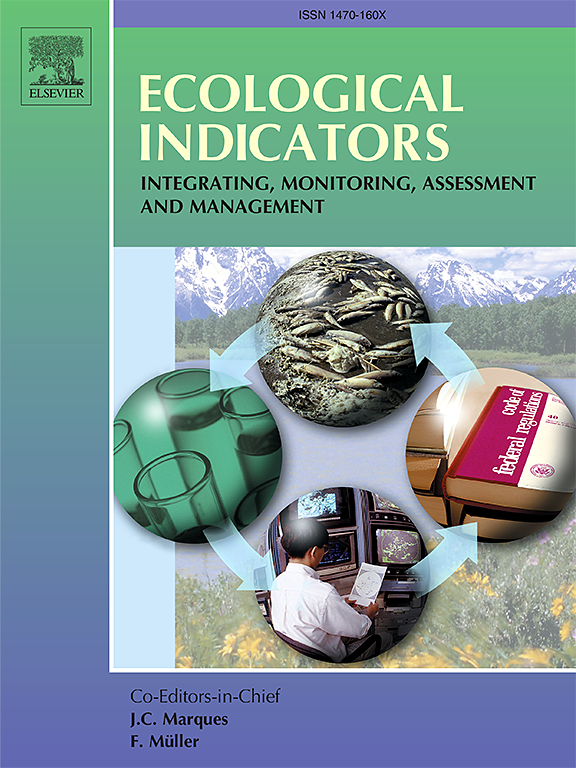中国特大城市群绿化时空特征及驱动力分析
IF 7
2区 环境科学与生态学
Q1 ENVIRONMENTAL SCIENCES
引用次数: 0
摘要
及时监测城市群绿化动态并分析其驱动因素对可持续发展具有重要意义。然而,目前对城市群尺度下植被绿化率的研究还很有限。本文以长三角、长三角、珠三角、成渝4个主要城市群为研究对象,在2000-2023年的30 m空间分辨率下,对其绿地动态特征及其驱动因素进行了研究。利用间隙填充和Savitzky-Golay滤波(GF-SG)方法、像素二分法、时空动态分析和地理探测器等创新的综合方法,对城市群绿地动态进行了更全面的认识。结果表明了几个关键点:1。在北京、长三角、珠三角、CC区域,植被绿度增加的区域占比(27.69%、14.10%、31.56%、23.09%)始终大于植被绿度减少的区域占比(4.3%、6.78%、5.11%、1.62%),城市中心区域的绿化度均显著增加,而城市扩张边缘区域的绿化度显著降低;2. 土地覆被转换成为绿化变化的主导驱动因子(q值最高为0.5743),表明土地覆被转换的作用大于自然因子。3. 城市用地的扩张和生态用地的恢复是城市绿地增减的主要原因。与此同时,四个城市群绿地变化所对应的初级土地覆被转换也存在差异。这些发现不仅有助于理解城市绿化动态,而且为土地覆盖转换在形成植被格局中的作用提供了新的视角。本文章由计算机程序翻译,如有差异,请以英文原文为准。

Analysis of the spatio-temporal characteristics and driving forces of greenness in mega urban agglomerations in China
Timely monitoring of greenness dynamics in urban agglomerations and analyzing their driving factors are important for sustainable development. However, current research on vegetation greenness at the scale of urban agglomerations remains limited. This study examines the greenness dynamics and its driving factors in China’s four major urban agglomerations Beijing–Tianjin–Hebei (BTH), Yangtze River Delta (YRD), Pearl River Delta (PRD), Chengdu–Chongqing (CC) at a 30-meter spatial resolution over a long period (2000–2023). The use of an innovative integrated approach, combining the Gap Filling and Savitzky–Golay filtering (GF-SG) method, pixel dichotomy model, spatiotemporal dynamic analysis and geographical detector, provides a more comprehensive understanding of greenness dynamics in urban agglomerations. The results indicate several key points: 1.The proportion of areas where vegetation greenness increased (27.69 %, 14.10 %, 31.56 %, 23.09 %) is consistently larger than the proportion of areas where greenness decreased (4.3 %, 6.78 %, 5.11 %, 1.62 %) within BTH, YRD, PRD, CC. Greenness is dramatically increasing in all urban centers, but significantly decreasing at the edges of urban expansion; 2. Land cover conversions emerged as the dominant driver of greenness changes (the highest Q-value is 0.5743), which indicates that land cover conversions play a greater role than natural factors. 3. The expansion of urban land and ecological land restoration explain the main reasons for the decrease and increase in greenness. Meanwhile, there are differences in the primary land cover conversions corresponding to the greenness changes among the four urban agglomerations. These findings not only contribute to understanding urban greenness dynamics but also offer a new perspective on the role of land cover conversions in shaping vegetation patterns.
求助全文
通过发布文献求助,成功后即可免费获取论文全文。
去求助
来源期刊

Ecological Indicators
环境科学-环境科学
CiteScore
11.80
自引率
8.70%
发文量
1163
审稿时长
78 days
期刊介绍:
The ultimate aim of Ecological Indicators is to integrate the monitoring and assessment of ecological and environmental indicators with management practices. The journal provides a forum for the discussion of the applied scientific development and review of traditional indicator approaches as well as for theoretical, modelling and quantitative applications such as index development. Research into the following areas will be published.
• All aspects of ecological and environmental indicators and indices.
• New indicators, and new approaches and methods for indicator development, testing and use.
• Development and modelling of indices, e.g. application of indicator suites across multiple scales and resources.
• Analysis and research of resource, system- and scale-specific indicators.
• Methods for integration of social and other valuation metrics for the production of scientifically rigorous and politically-relevant assessments using indicator-based monitoring and assessment programs.
• How research indicators can be transformed into direct application for management purposes.
• Broader assessment objectives and methods, e.g. biodiversity, biological integrity, and sustainability, through the use of indicators.
• Resource-specific indicators such as landscape, agroecosystems, forests, wetlands, etc.
 求助内容:
求助内容: 应助结果提醒方式:
应助结果提醒方式:


